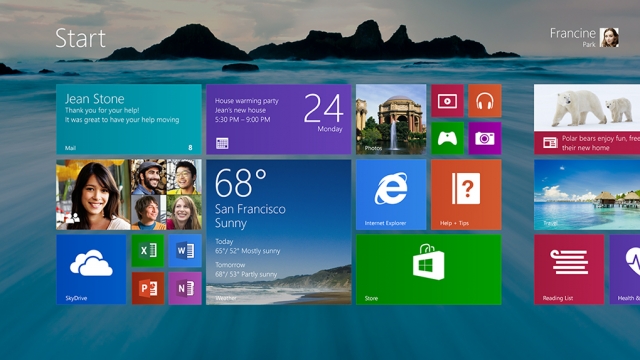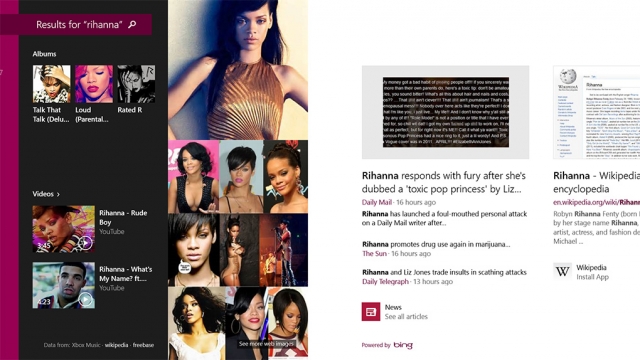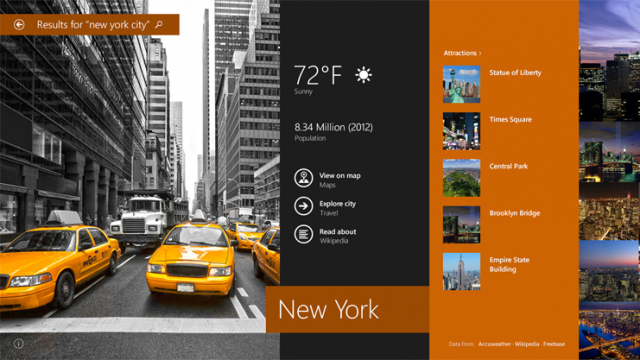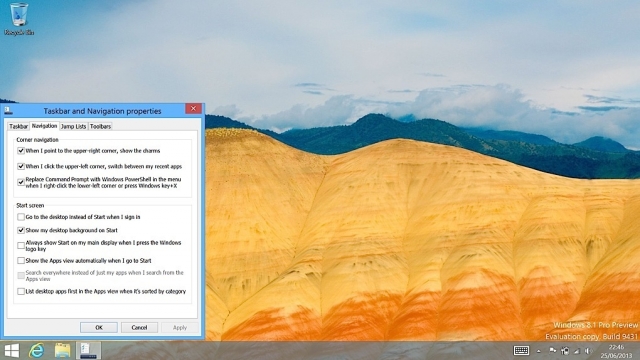Microsoft has taken a few ideas from Windows Phone, its mobile operating system, representing small and large-sized tiles on the start screen. Now, the sizing of the tiles offers more control and customizing options. The time tile now provides information about up to 3 different locations. The calendar may display all events for the day. The tiles are animated and present different information and tiles of programs by other developers, for example, by Twitter. The smallest tile has a new size which allows you to save space without sacrificing the beautiful animated effects. The arrangement of the icons in the startup screen is easier because you can grip and move several tiles at a time. The auto-tile home screen is no longer present because all icons were placed on it, including those which the user does not need, which required additional "cleaning" of the unnecessary tiles after the installation of each new application. Now the screen is new and brings all applications into one place whereas the home screen and its appearance remain a user territory. In this regard, Microsoft allows the user to insert wallpaper, including interactive or "live" wallpapers.

The biggest change is associated with the possibility of pinning the active metro applications. This option was limited in Windows 8 as it allowed simultaneous pinning of only two applications, which was insufficient for large screens. Pinning of applications was not possible on low-resolution screens but this option is already available due to the development of mobile devices with a resolution of 1024x768. They will be able to display two applications at a time which will split the screen 50:50.

Search

Bing, developed by Microsoft, is deeply integrated into Windows 8.1. Any information is available and it is presented as local, as if it is available on your device. The appearance is impressive indeed. Actually, the idea is that there is no difference between local search and searching for information on the web. In addition, everything is arranged in a pleasant and beautiful view which is easy to use and navigate and which combines text, images and video.

Bing supports the option of searching directly from the screen of Windows 8.1 but, according to Microsoft, this is only the beginning. The new way of presenting the search results will be introduced in Windows Phone as well, which will be another step towards the full merger of the mobile and desktop operating systems.
The return of the Start button

Many users are criticizing Microsoft for being too hasty in merging the elements of the mobile and desktop operating systems. The removal of the start menu has sparked a wave of discontent and arguments that “Metro” is not convenient for working with a mouse and keyboard. Microsoft has partly heard the voice of users and returned the removed Start button whose absence was confusing to regular users. There is no sign of the start menu, the button represents a direct connection to the new start screen. Windows 8.1 has an option for direct entry into the classic desktop environment without having to go through the start screen.

E-mail and Office

The e-mail application was deeply criticized for the lack of some basic features. The company demonstrated some of the operating innovations which are not currently present in the preliminary version of Windows 8.1 and which will be added later. The application includes drag-and-drop options, grouping of messages from social networks and newsletters. One of the things that is not working well yet is the option of pinning another “Metro” application to the e-mail user for a quick overview of a link or photo from an e-mail.
The company demonstrated the office suite that is prepared to work entirely in the “Metro” environment. It will be available later in the year as it is in the early stages of development.
Internet Explorer 11
Great attention has been paid to the new version of the browser which has been divided into two separate versions: one for “Metro” and the other for the desktop environment. The browser now supports over 100 open tabs to be synchronized with other devices. The tabs are moved to the bottom of the screen and in addition to the unlimited number of pages open, the browser allows you to save your favourite sites in folders and subfolders as well as to create “live” tiles of individual sites along with access to RSS feeds.
The merger of local and Internet content is enhanced by the deeper integration of Microsoft cloud service, Sky Drive. Everything stored in the cloud is visible on the new device with Windows 8.1, but its synchronisation is not automatic. This happens when you open the specific file. The Sky Drive folder is visible as a local folder and all settings, applications and their history is automatically saved in the cloud, ready for restoration or use on a new device with Windows 8.1.
